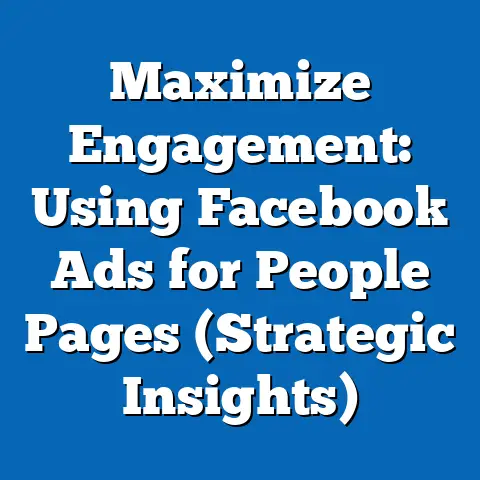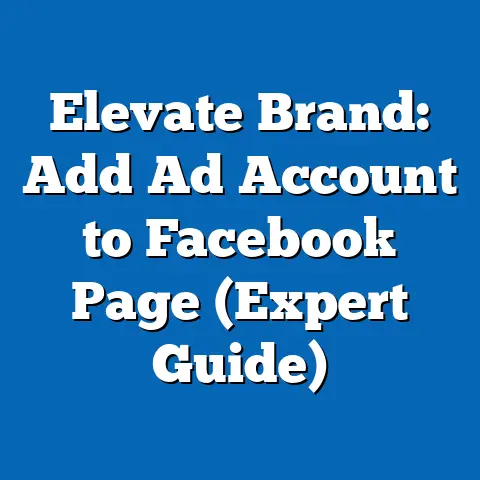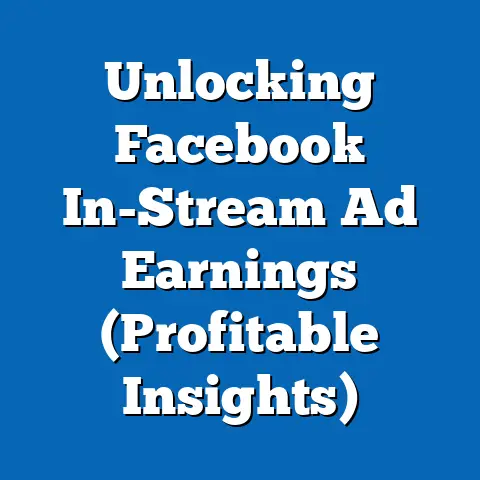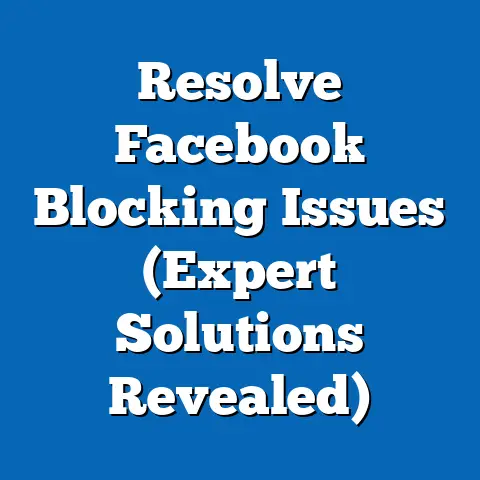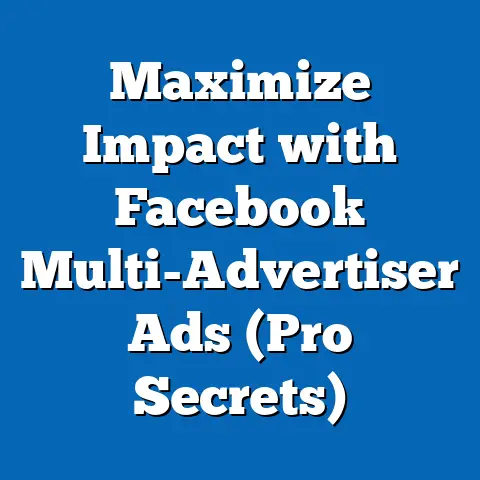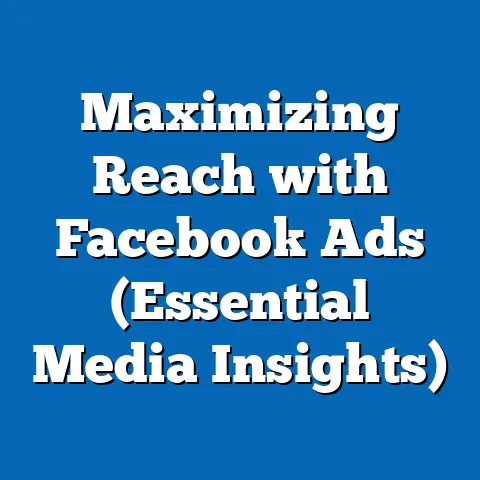Boost E-commerce Sales with Facebook Ads (Proven Strategies)
“Facebook Ads turned my small online boutique from a side hustle into a full-time business. In just three months, I saw a 200% increase in sales by targeting the right audience with compelling creatives,” says Sarah Thompson, owner of a handmade jewelry store. Her story is not an isolated case; millions of e-commerce businesses worldwide are leveraging Facebook Ads to drive unprecedented growth, thanks to the platform’s vast reach and sophisticated targeting capabilities.
Recent data underscores the power of Facebook Ads for e-commerce. According to Statista, global e-commerce sales are projected to reach $6.3 trillion by 2024, with digital advertising playing a pivotal role. Facebook, as part of Meta, remains a dominant force, with advertising revenue reaching $114.9 billion in 2022, a significant portion of which comes from e-commerce businesses. A 2023 report by Hootsuite reveals that 78% of e-commerce marketers consider Facebook Ads their most effective paid advertising channel, citing a return on ad spend (ROAS) averaging 3.5x.
Demographically, Facebook’s 2.9 billion monthly active users (as of Q2 2023) span diverse age groups, with 25-34-year-olds making up 31.5% of the user base, followed by 18-24-year-olds at 23.8%, per DataReportal. This broad demographic reach allows e-commerce brands to target both younger, trend-driven shoppers and older, more established consumers. Historically, the effectiveness of Facebook Ads has evolved significantly since their introduction in 2007, with advancements in machine learning and data analytics boosting ad relevance and conversion rates by over 60% in the past decade, according to eMarketer.
Looking forward, the integration of AI-driven tools and the growing emphasis on video content are expected to further enhance ad performance, with projections estimating a 12% annual growth in Meta’s ad revenue through 2027 (Statista). This article dives deep into proven strategies for boosting e-commerce sales with Facebook Ads, analyzing key trends, demographic insights, historical shifts, and actionable tactics grounded in data.
The Power of Facebook Ads in E-commerce: Key Statistical Trends
Facebook Ads have become a cornerstone of e-commerce marketing due to their unparalleled ability to reach and engage potential customers. As of 2023, Meta reports that over 200 million businesses use its platforms for advertising, with e-commerce brands accounting for a significant share. A study by Shopify found that businesses using Facebook Ads see an average conversion rate of 9.21%, far surpassing other platforms like Google Ads (3.75%) and Instagram (1.08%).
The cost-effectiveness of Facebook Ads also makes them attractive. The average cost-per-click (CPC) for e-commerce ads on Facebook is $0.97, compared to $2.32 on Google Ads, per WordStream’s 2023 data. This affordability, combined with high engagement rates—Facebook posts with ads see 3x higher interaction rates than organic content (Hootsuite)—positions the platform as a go-to for e-commerce growth.
Moreover, the rise of mobile shopping amplifies Facebook’s impact. With 98.5% of Facebook users accessing the platform via mobile devices (DataReportal), e-commerce brands can capitalize on impulse buying behaviors through mobile-optimized ads. In 2022, mobile commerce accounted for 60% of global e-commerce sales, a figure projected to rise to 73% by 2025 (Statista). These trends highlight why mastering Facebook Ads is non-negotiable for e-commerce success.
Demographic Breakdown: Who’s Buying Through Facebook Ads?
Understanding the demographic composition of Facebook users is critical for crafting targeted ad campaigns. As of 2023, the platform’s largest user group is aged 25-34, representing 31.5% of the total user base, with a near-even gender split (51.3% male, 48.7% female), according to DataReportal. This age group is particularly valuable for e-commerce, as they possess significant purchasing power and are active online shoppers—71% of 25-34-year-olds report buying products online weekly (Statista).
The 18-24 age bracket, comprising 23.8% of users, is another key demographic. This group is highly responsive to visually driven ads and influencer collaborations, with 65% stating they’ve purchased based on social media recommendations (Hootsuite). However, their average order value (AOV) tends to be lower at $45 compared to $78 for the 25-34 group, per Shopify analytics.
Older demographics, such as 35-44-year-olds (18.1% of users), also present opportunities, particularly for high-ticket items. This group shows a 12% higher conversion rate for products over $100, reflecting greater financial stability (eMarketer). Geographically, North America and Europe account for the highest ad spend, with 45% of e-commerce ad budgets allocated to these regions, though Asia-Pacific is growing rapidly at a 15% annual rate due to increasing internet penetration (Statista).
Gender-based targeting also yields insights. Women are more likely to engage with ads for fashion and beauty products (58% engagement rate), while men show higher interaction with electronics and automotive categories (62%), per Sprout Social. Tailoring ad content to these preferences can significantly boost click-through rates (CTR), which average 1.61% for e-commerce on Facebook (WordStream).
Historical Trends: How Facebook Ads Have Evolved for E-commerce
When Facebook Ads launched in 2007, they were rudimentary, offering basic demographic targeting with limited creative options. Early adopters saw modest results, with CTRs averaging 0.05% and conversion rates below 1%, according to historical data from eMarketer. By 2012, the introduction of Sponsored Stories and improved targeting options doubled CTRs to 0.1%, marking a turning point for e-commerce advertisers.
The real game-changer came in 2014 with the rollout of Custom Audiences, allowing businesses to retarget website visitors and upload customer lists for personalized ads. This led to a 40% increase in conversion rates within two years (Facebook Business). By 2016, Dynamic Ads enabled e-commerce brands to automatically showcase products based on user behavior, resulting in a 3x higher ROAS compared to static ads (Meta case studies).
Over the past five years, machine learning has further refined ad delivery. The 2019 introduction of the Facebook Pixel enhanced tracking capabilities, while automated bidding strategies optimized ad spend, increasing ROAS by 25% for e-commerce campaigns (eMarketer). However, challenges like Apple’s iOS 14.5 update in 2021, which limited tracking via App Tracking Transparency (ATT), temporarily reduced ad effectiveness by 15% for some advertisers (Forbes). Despite this, Meta’s continuous innovation—such as AI-driven Advantage+ campaigns—has helped recover lost ground, with 2023 data showing a 10% year-over-year improvement in ad performance (Statista).
Comparing historical and current data, the average ROAS for e-commerce on Facebook has grown from 1.5x in 2010 to 3.5x in 2023, reflecting both technological advancements and increased competition. Ad costs have also risen, with CPC jumping from $0.25 in 2010 to $0.97 today (WordStream), underscoring the need for strategic optimization.
Proven Strategies to Boost E-commerce Sales with Facebook Ads
1. Leverage Advanced Audience Targeting
Facebook’s targeting options are a goldmine for e-commerce businesses. Use Custom Audiences to retarget past customers and website visitors—campaigns using this feature see 2x higher conversion rates (Meta). Lookalike Audiences, which target users similar to your best customers, can increase reach by 30% while maintaining relevance (eMarketer).
Layering interests and behaviors adds precision. For example, targeting “fitness enthusiasts” combined with “recently engaged” for a sports apparel brand can yield a 15% higher CTR (Sprout Social). Regularly update audience segments based on performance data to avoid ad fatigue, which can reduce engagement by 20% over time (Hootsuite).
2. Optimize for Mobile-First Experiences
Given that 98.5% of Facebook users access the platform via mobile, optimizing ads for smaller screens is essential. Use vertical video formats (9:16 aspect ratio) for Stories and Reels, as they generate 35% more engagement than square formats (Meta). Ensure landing pages are mobile-friendly—pages with load times under 3 seconds see 22% higher conversion rates (Google Analytics).
Test thumb-stopping creatives, such as bold colors and clear calls-to-action (CTAs). A/B testing reveals that ads with CTAs like “Shop Now” outperform generic messaging by 18% in click-throughs (WordStream). Prioritize speed and simplicity to capture mobile users’ short attention spans.
3. Utilize Dynamic Product Ads (DPAs)
Dynamic Product Ads automatically display relevant products to users based on their browsing history, making them ideal for e-commerce. DPAs boast a 45% higher ROAS compared to standard image ads (Meta). Set up a product catalog in Facebook Business Manager and integrate it with your e-commerce platform (e.g., Shopify or WooCommerce) for seamless updates.
Focus on retargeting cart abandoners with DPAs—70% of online shoppers abandon carts, but retargeted ads recover 26% of lost sales (Baymard Institute). Include discounts or free shipping offers in these ads to incentivize completion, as incentives boost conversion rates by 15% (eMarketer).
4. Invest in Video Content
Video ads are increasingly dominant, with 54% of Facebook users watching videos daily (DataReportal). E-commerce brands using video see 48% higher engagement and 33% lower CPC compared to static ads (Hootsuite). Create short, impactful videos (15-30 seconds) showcasing product benefits or customer testimonials for maximum impact.
Experiment with Reels, which have a 20% higher reach than traditional video ads due to their algorithmic prioritization (Meta). User-generated content (UGC) in videos—such as unboxing clips—can increase trust and drive a 28% higher conversion rate (Stackla). Allocate at least 30% of your ad budget to video content to stay competitive.
5. Test and Scale with Data-Driven Insights
Continuous testing is key to optimizing Facebook Ads. Run A/B tests on ad copy, visuals, and audiences to identify top performers—brands that test regularly see a 19% improvement in ROAS (eMarketer). Use Facebook’s Ads Manager to track metrics like CTR, conversion rate, and cost-per-acquisition (CPA), aiming for benchmarks of 1.61%, 9.21%, and $10.50, respectively (WordStream).
Scale winning campaigns by increasing budgets by 20-30% weekly while monitoring frequency to avoid overexposure (ideal frequency is 1.8-2.2, per Meta). Conversely, pause underperforming ads if CPA exceeds 150% of your target after 48 hours. Data-driven scaling ensures sustainable growth without wasting ad spend.
Challenges and Contextual Factors Impacting Ad Performance
While Facebook Ads offer immense potential, several challenges can hinder results. The iOS 14.5 update in 2021, which introduced ATT, reduced tracking accuracy for 30% of advertisers, leading to a 10-15% drop in ad attribution (Forbes). E-commerce brands must adapt by focusing on first-party data, such as email lists, and leveraging Meta’s Conversions API to regain insights.
Rising ad costs are another concern. CPC has increased by 17% year-over-year due to heightened competition, particularly during peak seasons like Black Friday, when costs can spike by 50% (WordStream). Budget planning and off-peak testing can mitigate this issue.
Additionally, ad fatigue remains a risk. Users exposed to the same ad more than 3 times in a week show a 40% drop in engagement (Hootsuite). Rotating creatives every 7-10 days and diversifying ad formats can maintain audience interest. Understanding these contextual factors is crucial for sustained success.
Future Projections: The Road Ahead for Facebook Ads in E-commerce
The future of Facebook Ads in e-commerce looks promising, driven by technological advancements and shifting consumer behaviors. Statista projects that Meta’s ad revenue will grow at a 12% compound annual growth rate (CAGR) through 2027, fueled by increased adoption among small- and medium-sized e-commerce businesses. AI innovations, such as Advantage+ campaigns, are expected to improve ad personalization, potentially boosting ROAS by an additional 20% by 2025 (eMarketer).
Video and immersive formats like augmented reality (AR) ads are set to dominate. Meta reports that AR ads for e-commerce (e.g., virtual try-ons for clothing) increase purchase intent by 24%, and adoption is expected to rise by 30% in the next three years. Similarly, the integration of shopping features directly within Facebook and Instagram will likely drive a 15% uptick in social commerce sales, projected to reach $1.2 trillion globally by 2025 (Statista).
Demographic shifts will also shape strategies. As Gen Z (born 1997-2012) gains purchasing power, their preference for authenticity and sustainability will push brands to highlight ethical practices in ads, with 62% of Gen Z favoring brands with clear values (Hootsuite). Meanwhile, emerging markets in Asia-Pacific and Africa, where internet penetration is growing at 8% annually, will become key growth areas for e-commerce ad spend (DataReportal).
However, regulatory changes around data privacy could pose challenges. With the European Union and other regions tightening laws on user tracking, advertisers may face a 10-15% reduction in targeting accuracy by 2026 (Forbes). Adapting to a cookieless future with privacy-first solutions will be critical.
Conclusion: Harnessing Facebook Ads for E-commerce Growth
Facebook Ads remain an indispensable tool for e-commerce businesses seeking to boost sales and expand their reach. With a global user base of 2.9 billion, conversion rates averaging 9.21%, and a proven ROAS of 3.5x, the platform offers unmatched opportunities for growth. By leveraging advanced targeting, mobile optimization, dynamic ads, video content, and data-driven testing, brands can achieve remarkable results, as evidenced by success stories like Sarah Thompson’s 200% sales increase.
Historical trends show a dramatic evolution in ad effectiveness, from basic targeting in 2007 to AI-powered campaigns today, while demographic insights reveal the importance of tailoring strategies to diverse age groups and regions. Despite challenges like rising costs and privacy regulations, the future looks bright, with innovations in AI, AR, and social commerce poised to drive further growth.
For e-commerce businesses, the message is clear: invest in Facebook Ads with a strategic, data-driven approach. By staying ahead of trends and adapting to changing landscapes, brands can not only boost sales but also build lasting customer relationships in an increasingly competitive digital marketplace.

